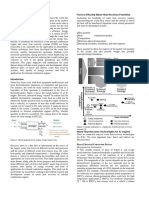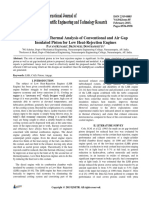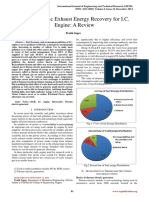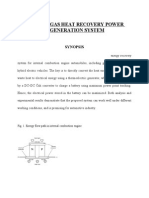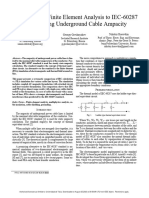ExtractionofWasteheat
ExtractionofWasteheat
Uploaded by
vishal.20213044Copyright:
Available Formats
ExtractionofWasteheat
ExtractionofWasteheat
Uploaded by
vishal.20213044Copyright
Available Formats
Share this document
Did you find this document useful?
Is this content inappropriate?
Copyright:
Available Formats
ExtractionofWasteheat
ExtractionofWasteheat
Uploaded by
vishal.20213044Copyright:
Available Formats
See discussions, stats, and author profiles for this publication at: https://www.researchgate.
net/publication/354860522
Extraction of waste heat from exhaust of internal combustion engines, to be
used for useful purpose
Article in Basic and Applied Ecology · September 2021
CITATIONS READS
0 1,511
1 author:
Anil Kumar
G B PANT GOVERNMENT ENGINEERING COLLEGE (DELHI SKILL & ENTREPRENEURSHIP UNIVERSITY NEW DELHI
16 PUBLICATIONS 68 CITATIONS
SEE PROFILE
All content following this page was uploaded by Anil Kumar on 27 September 2021.
The user has requested enhancement of the downloaded file.
INTERNATIONAL JOURNAL OF BASIC AND APPLIED RESEARCH
www.pragatipublication.com
ISSN 2249-3352 (P) 2278-0505 (E)
Extraction of waste heat from exhaust of internal combustion engines, to be used for
useful purpose
Anil Kumar
Department of Mechanical & Automation Engineering, G B Pant Engineering College, Okhla,
Delhi-110020
Abstract
In Internal combustion engines, efficiency of engine is around 30 %, roughly 30% of the fuel
energy is wasted in exhaust gases, and 30% in cooling and 10% are unaccountable losses. Efforts
are made to catch this 30% energy of exhaust gases. If this waste heat energy is tapped and
converted into usable energy, the overall efficiency of an engine can be improved.
Here, we have modified an automobile for extracting heat from the exhaust. We have
demonstrated a concept of extracting heat in a moving vehicle by using copper coil as heat
exchanger. We allowed exhaust gases coming out of engine to pass through an insulated box. The
Heat carried by the exhaust gases is extracted inside the box through copper coil and can be used
for various purposes.
Keywords: Heat exchanger, exhaust, four stroke engine, Exhaust Gas Temperature Gauge, LMTD
1. Introduction
Problem Definition
In recent years the scientific and public awareness on environmental and energy issues has
brought in major interests to the research of advanced technologies particularly in highly efficient
internal combustion engines.
Substantial thermal energy is available from the exhaust gases in modern automotive engines.
Two-thirds of the energy from combustion in a vehicle is lost as waste heat, of which 30-40% is in
the form of hot exhaust Gas.
So the main problem is –
“The large amount of heat carried by the exhaust gases goes waste into environment”.
This large amount of energy from the stream of exhausted gases could potentially be used
for waste heat energy recovery to increase the work output of the engine.
The latest developments and technologies on waste heat recovery of exhaust gas from internal
combustion engines (ICE) includes thermoelectric generators (TEG), Organic Rankine cycle
(ORC), six-stroke cycle IC engine and new developments on turbocharger Technology.
107 Received: 5 January Revised: 13 January Accepted: 22 January
Index in Cosmos
February 2018 Volume 8 Number 2
UGC APPROVED
INTERNATIONAL JOURNAL OF BASIC AND APPLIED RESEARCH
www.pragatipublication.com
ISSN 2249-3352 (P) 2278-0505 (E)
2. LITERATURE REVIEW
A- Various researches done related to exhaust heat recovery are as under-
1. ―A highly efficient six-stroke internal combustion engine cycle with water injection for in-
cylinder exhaust heat recovery‖ by Conklin JC, Szybist JP.
A concept adding two strokes to the Otto or Diesel engine cycle to increase fuel efficiency is
presented here. It can be thought of as a four-stroke Otto or Diesel cycle followed by a two-stroke
heat recovery steam cycle. A partial exhaust event coupled with water injection adds an additional
power stroke. Waste heat from two sources is effectively converted into usable work: engine
coolant and exhaust gas. Conklin and Szybist investigated that the percentage of fuel energy
converted to useful work only 10.4% and also found the thermal energy lost through exhaust gas
about 27.7%.
2. ―Performance of a Thermo acoustic Sound Wave Generator driven with Waste Heat of
Automobile Gasoline Engine‖ by Hatazawa M, Sugita H, Ogawa T, SeoY.
A new type of thermo acoustic sound wave generator driven with the waste heat of a 4cycle
automobile gasoline engine is described. The exhaust-pipe connected sound wave generator, in
which the hot heat exchanger is set in the exhaust pipe in order to recover the waste heat of
exhaust gas, is proposed. A temperature of 780°C of exhaust gas in the exhaust is observed. In a
conventional thermo acoustic sound wave generator, sound waves originate at a temperature of
the hot heat exchanger, TH, of 200-300°C and become sufficient at 700°C. It is confirmed that the
new generator generates sufficient sound waves and its performance is almost equal to that of the
electric heater driven generator at a thermal input of 300 W, which corresponds to slightly more
than 1% of the heat quantity of exhaust gas provided under the condition that the number of
engine revolutions is 2 600 rpm and that the throttle opening is 35%.
3. ―Potential applications of thermoelectric waste heat recovery in the automotive industry‖ by
Yang J.
Several proposed applications of thermoelectric (TE) waste heat recovery devices in the
automotive industry are reviewed. To assess the feasibility of these applications at a vehicle level,
the effect of electrical load and weight on fuel economy for a series of cars and trucks was
investigated. These results will help us to identify the appropriate vehicle platforms for TE waste
heat recovery, and to establish a set of requirements for an automotive TE waste heat recovery
subsystem. The key to the realization of this technology is still the continued development of new
materials with increased efficiency.
4. ―Automobile engine tribology — approaching the surface‖ by C.M. Taylor.
There has been relentless pressure in the second half of the 20th century to develop ever more
fuel efficient and compact automobile engines with reduced environmental impact.
From the viewpoint of the tribologist this means increasing specific loads, speeds and
temperatures for the major frictional components of the engine, namely, the piston assembly, the
valve train and the journal bearings, and lower viscosity engine oils with which to lubricate them.
Inevitably, this leads to decreasing oil film thicknesses between the interacting surfaces of these
components and a more crucial role for the topography and surface profile of the two surfaces in
determining tribological performance. This paper reviews the nature of the surfaces encountered
in the piston assembly, valve train and journal bearings of the internal combustion engine and how
108 Received: 5 January Revised: 13 January Accepted: 22 January
Index in Cosmos
February 2018 Volume 8 Number 2
UGC APPROVED
INTERNATIONAL JOURNAL OF BASIC AND APPLIED RESEARCH
www.pragatipublication.com
ISSN 2249-3352 (P) 2278-0505 (E)
mathematical models of engine tribology are endeavoring to cope with the extreme complexities
the incorporation of surface topography potentially brings.
5. ―Automotive Thermoelectric Generator Design Issues‖ by Francis Stabler.
Automotive applications for thermoelectric materials are growing in importance, driven by the
customer’s desire for high efficiency and for more features. Most thermoelectric applications can
be divided into one of two segments. One segment is based on the Peltier effect and it’s focused
on various applications of heating or cooling. The other segment is based on the Seebeck effect
and is focused on power generation, primarily from waste heat. The heating and cooling
applications will be addressed first because some of these applications are already in production.
Various Energy Losses in a Vehicle
As Per California Energy Commission
Only about 15 percent of the energy from the fuel you put in your tank gets used to move your car
down the road or run useful accessories, such as air conditioning. The rest of the energy is lost to
engine and driveline inefficiencies and idling. Therefore, the potential to improve fuel efficiency
with advanced technologies is enormous.
Engine Losses - 62.4 percent
Idling Losses - 17.2 percent
Accessories - 2.2 percent
Driveline Losses - 5.6 percent
Aerodynamic Drag - 2.6 percent
Rolling Resistance - 4.2 percent
Overcoming Inertia; Braking Losses - 5.8 percent
In addition, any time you use your brakes, energy initially used to overcome inertia is lost.
Only about 15 percent of the energy from the fuel you put in your tank gets used to move your car
down the road or run useful accessories, such as air conditioning. The rest of the energy is lost to
engine and driveline inefficiencies and idling. Therefore, the potential to improve fuel efficiency
with advanced technologies is enormous.
1. Possibility of heat recovery and availability from I.C. Engine
Waste heat is heat, which is generated in a process by way of fuel combustion or chemical
reaction, and then ―dumped‖ into the environment even though it could still be reused for some
useful and economic purpose. This heat depends in part on the temperature of the waste heat
gases and mass flow rate of exhaust gas. Waste heat losses arise both from equipment
inefficiencies and from thermodynamic limitations on equipment and processes.
Exhaust gases immediately leaving the engine can have temperatures as high as 842-1112°F [450-
600°C]. Consequently, these gases have high heat content, carrying away as exhaust emission.
Fig. 1 shows total energy distributions from internal combustion engine.
109 Received: 5 January Revised: 13 January Accepted: 22 January
Index in Cosmos
February 2018 Volume 8 Number 2
UGC APPROVED
INTERNATIONAL JOURNAL OF BASIC AND APPLIED RESEARCH
www.pragatipublication.com
ISSN 2249-3352 (P) 2278-0505 (E)
Figure 1-Heat distribution of an engine
B. Approximate Waste Heat from Internal Combustion Engine
C. Heat Exchanger
Heat exchangers are devices used to transfer heat energy from one fluid to another. Typical heat
exchangers experienced by us in our daily lives include condensers and evaporators used in air
conditioning units and refrigerators. Boilers and condensers in thermal power plants are examples
of large industrial heat exchangers. There are heat exchangers in our automobiles in the form of
radiators and oil coolers. Heat exchangers are also abundant in chemical and process industries.
Heat Transfer Considerations
The energy flow between hot and cold streams, with hot stream in the bigger diameter tube, is as
shown in Figure 7.1. Heat transfer mode is by convection on the inside as well as outside of the
inner tube and by conduction across the tube. Since the heat transfer occurs across the smaller
tube, it is this internal surface which controls the heat transfer process. By convention, it is the
outer surface, termed Ao, of this central tube which is referred to in describing heat exchanger
area. Applying the principles of thermal resistance,
If we define overall the heat transfer coefficient, Uc, as:
Substituting the value of the thermal resistance R yields:
110 Received: 5 January Revised: 13 January Accepted: 22 January
Index in Cosmos
February 2018 Volume 8 Number 2
UGC APPROVED
INTERNATIONAL JOURNAL OF BASIC AND APPLIED RESEARCH
www.pragatipublication.com
ISSN 2249-3352 (P) 2278-0505 (E)
Standard convective correlations are available in text books and handbooks for the convective
coefficients, ho and hi. The thermal conductivity, k, corresponds to that for the material of the
internal tube. To evaluate the thermal resistances, geometrical quantities (areas and radii) are
determined from the internal tube dimensions available.
Fouling
Material deposits on the surfaces of the heat exchanger tubes may add more thermal resistances to
heat transfer. Such deposits, which are detrimental to the heat exchange process, are known as
fouling. Fouling can be caused by a variety of reasons and may significantly affect heat exchanger
performance. With the addition of fouling resistance, the overall heat transfer coefficient, U c, may
be modified as:
Where R‖ is the fouling resistance.
With fouling, the expression for overall heat transfer coefficient becomes:
3. METHODOLOGY
Schematic Diagram:
Figure 2-Schematic diagram of proposal
1. Working:-
Apparatus is designed to extract the heat from exhaust of an IC engine. Exhaust from the
engine flow through an insulated tube, which is connected to exhaust pipe at one end and
insulated box at the other. Insulated tube helps to maintain temperature of the exhaust with
minimum atmospheric loss. In the box, exhaust flow through copper coil here heat is
111 Received: 5 January Revised: 13 January Accepted: 22 January
Index in Cosmos
February 2018 Volume 8 Number 2
UGC APPROVED
INTERNATIONAL JOURNAL OF BASIC AND APPLIED RESEARCH
www.pragatipublication.com
ISSN 2249-3352 (P) 2278-0505 (E)
extracted. Heat is transferred from exhaust to copper metal by convection, further followed by
conduction process. Rise in temperature of coil results in convection of heat to the box.
Heat transfer causes rise in temperature of the box. Exhaust exits from other side of box
through the insulated tube and connected to silencer. Continuous flow of exhaust from coil
results in increase in temperature of the box.
To maintain the desired temperature or to limit the temperature, a temperature sensor is
installed in the box. The sensor is connected to the battery fan. When the temperature exceeds
the desired value, the sensor sends signal to the fan. Fan starts and transfer heat to
surrounding, resulting in decrease in temperature.
When the apparatus is not in use the valve on the exhaust exit is open so that no exhaust
flows through the insulated tube.
2. Components:-
1) Cylindrical box: - Cylindrical box is used to capture the extracted heat and acts as
heating box.
2) Copper coil (Heat Exchanger): - A heat exchanger is a device used to transfer heat
between one or more fluids. The fluids may be separated by a solid wall to prevent mixing or
they may be in direct contact. Copper coil of outside diameter 0.5 inch is used.
3) Insulation: - Thermal insulation is the reduction of heat transfer (the transfer of thermal
energy between objects of differing temperature) between objects in thermal contact or in
range of radiative influence. A layer of insulation is fixed inside and outside cylindrical box to
trap heat extracted.
4) Battery operated fan: - Fan is run by motor, which is used to distribute heat evenly in the
cylinder.
5) Digital thermal sensor: - It is used to find the change in temperature with time
6) Switch: - It is used to on and off fan.
7) Cast iron connections: - Different types of socket are used to assemble the project
components.
Figure 23- various components used for fabrication
112 Received: 5 January Revised: 13 January Accepted: 22 January
Index in Cosmos
February 2018 Volume 8 Number 2
UGC APPROVED
INTERNATIONAL JOURNAL OF BASIC AND APPLIED RESEARCH
www.pragatipublication.com
ISSN 2249-3352 (P) 2278-0505 (E)
2. Fabrication:-
I. Copper coil is folded in the shape of cylindrical box.
II. Insulated sheet is fixed inside the box.
III. Insulated is fixed on the outside of the cylindrical box.
IV. Universal is attached to exhaust tube.
V. Screw is welded on the copper coil.
VI. Elbow and other connections are joined with screw.
VII. Fan is attached to the lid of box.
VIII. Exhaust pipe is insulated
IX. Box is attached to bike.
113 Received: 5 January Revised: 13 January Accepted: 22 January
Index in Cosmos
February 2018 Volume 8 Number 2
UGC APPROVED
INTERNATIONAL JOURNAL OF BASIC AND APPLIED RESEARCH
www.pragatipublication.com
ISSN 2249-3352 (P) 2278-0505 (E)
Figure 4- Step by step assembly of project
Assumption and data used while calculating heat transfer:-
i. Taking heat transfer coefficient of copper-401W/m2K
ii. Convective coefficient of air- 10.45 W/m2K
iii. Exhaust temperature-150°C
iv. Copper coil with inner and outer radius-0.0056m and 0.00635m
v. Number of copper tubes-7
vi. Fouling factor is not considered.
vii. Room temperature - 30°C
viii. Cylindrical box diameter- 0.3048m
ix. Height of cylindrical box-0.3048m
x. Exhaust flow rate- 48 CFM(cubic feet per min)
xi. Density of air at 30 C- 1.165Kg/m3
5. RESULT
1. Temperature of Exhaust
Exhaust gas temperature gauge:-An exhaust gas temperature gauge (EGT gauge) is a meter used
to monitor the exhaust gas temperature of an internal combustion engine in conjunction with a
thermocouple-type pyrometer. EGT gauges are found in certain cars and airplanes. By monitoring
EGT, the driver or pilot can get an idea of the vehicle's air-fuel ratio.
*Temperature of exhaust gas is around 150-200°C for Bajaj Caliber 115cc.
114 Received: 5 January Revised: 13 January Accepted: 22 January
Index in Cosmos
February 2018 Volume 8 Number 2
UGC APPROVED
INTERNATIONAL JOURNAL OF BASIC AND APPLIED RESEARCH
www.pragatipublication.com
ISSN 2249-3352 (P) 2278-0505 (E)
2. Calculating increase in temperature with time:-
Table 2- Observation table
Time (in Temperature (in degree
S. No. seconds) Celsius)
1 0 33.8
2 30 35
3 60 38.2
4 90 42.1
5 120 45.6
6 150 50
7 180 52
8 210 53.4
9 240 54.8
10 270 56
11 300 58.1
Tempterature-Time relation for Apparatus
65
60
55
Temperature(in degree
50
45
40
35
30
Celsius)
25
20 Temperature(in degree Celsius)
15
10
5
0
0 30 60 90 120 150 180 210 240 270 300 330
Time (in seconds)
Figure 5- Temperature vs. Time graph
Calculating Amount of Heat Transfer
Heat transferred- QT =U * A* F (LMTD)
So “Rate of heat transfer calculated from above formula is 250.67 J/min”.
6. Conclusion
SO by using this Method we will be able to find that we can use the heat of exhaust gases can be
utilized or can be used for a fruitful function. In our method the heat transfer rate is- is 250.67
J/min”
115 Received: 5 January Revised: 13 January Accepted: 22 January
Index in Cosmos
February 2018 Volume 8 Number 2
UGC APPROVED
INTERNATIONAL JOURNAL OF BASIC AND APPLIED RESEARCH
www.pragatipublication.com
ISSN 2249-3352 (P) 2278-0505 (E)
7. DISCUSSION
Objective of this project was to design, analyze and fabricate a method to extract heat from the
exhaust of IC engine. We found the amount of heat extracted and the increase in temperature of
the box in a fixed interval of time. The method has very vast application as the heat extracted is
free of cost. It can be customized as per the requirements.
8. SCOPE OF WORK
Delivery of food items for long distance.
Warming of insides of car during winter.
Could be used for the production of bio-fuel by growing of algae farms or could be used
in greenhouses or even used in Eco-industrial parks.
REFERENCES
1. Hatazawa M, SugitaH, OgawaT, SeoY. ―Performance of a thermo acoustic sound wave generator
driven with waste heat of automobile gasoline engine‖. Transactions of the Japan Society of
Mechanical Engineers 2004; 70(689):292–9.
2. Stabler F. ―Automotive applications of high efficiency thermoelectric‖, in DARPA/ONR program
review and DOE high efficiency thermoelectric workshop. 2002: San Diego, CA.
3. Taylor CM. ―Automobile engine tribology—design considerations for efficiency and durability‖.
Wear 1998; 221(1):1–8
4. Yang J. ―Potential applications of thermoelectric waste heat recovery in the automotive
industry‖, in International conference on thermoelectric 2005:155-159.
5. Omura, ―Mastering Autocad 2000 for Mechanical Engineers‖ BPB Publications, 2 nd Edition, 1998.
6. P.K. Nag, ―Engineering Thermodynamics‖, Tata McGraw Hill
7. R.K. Rajput, ―Thermal Engineering‖, Laxmi Publications.
8. Conklin JC, Szybist JP.‖A highly efficient six-stroke internal combustion engine cycle with water
injection for in-cylinder exhausts heat recovery‖. Energy 2010; 35:1658–64.
116 Received: 5 January Revised: 13 January Accepted: 22 January
Index in Cosmos
February 2018 Volume 8 Number 2
UGC APPROVED
View publication stats
You might also like
- Fundamentals of Thermal-Fluid Sciences 6th Edition Cengel Download PDFDocument64 pagesFundamentals of Thermal-Fluid Sciences 6th Edition Cengel Download PDFamarinnieky100% (3)
- Review On Recovery and Utilization of Waste Heat in Internal Combustion EngineDocument7 pagesReview On Recovery and Utilization of Waste Heat in Internal Combustion EngineMayur PKNo ratings yet
- Energy and Energy Analysis On Si Engine by Blend o PDFDocument14 pagesEnergy and Energy Analysis On Si Engine by Blend o PDFJagesh ChauhanNo ratings yet
- Fabrication of Air Brake System Using Engine Exhaust GasDocument3 pagesFabrication of Air Brake System Using Engine Exhaust GasKamran ImtiyazNo ratings yet
- Projeect PPT-1Document28 pagesProjeect PPT-1Shubham PawarNo ratings yet
- Projeect PPT-1Document28 pagesProjeect PPT-1Shubham PawarNo ratings yet
- IoT Technology and STM32 Microcontroller Based Design of Smart SuitcaseDocument5 pagesIoT Technology and STM32 Microcontroller Based Design of Smart Suitcasesijophilip30No ratings yet
- My Advocacy Web ComputerDocument12 pagesMy Advocacy Web ComputerDarylle Mei AvergonzadoNo ratings yet
- Viable Combined Cycle Design For Automotive Applications: K.-B. KIM, K.-W. CHOI and K.-H. LEEDocument7 pagesViable Combined Cycle Design For Automotive Applications: K.-B. KIM, K.-W. CHOI and K.-H. LEEsaeedalipourNo ratings yet
- Design and Fabrication of Air Brake System Using Engine Exhaust GasDocument11 pagesDesign and Fabrication of Air Brake System Using Engine Exhaust Gasscholarship cptcNo ratings yet
- New Design For A 2 KW Capacity Cooling System Powered by Exhaust Gases of A Diesel EngineDocument9 pagesNew Design For A 2 KW Capacity Cooling System Powered by Exhaust Gases of A Diesel EngineAl-Mustaqbal Journal of Sustainability in Engineering SciencesNo ratings yet
- A Review of Performance Evaluation and Efficiency Analysis of Automotive Waste Heat Recovery Technologies (1) 1Document6 pagesA Review of Performance Evaluation and Efficiency Analysis of Automotive Waste Heat Recovery Technologies (1) 1John Ian AsuncionNo ratings yet
- Performance and Evaluation of Aqua Ammonia Auto Air Conditioner System Using Exhaust Waste EnergyDocument10 pagesPerformance and Evaluation of Aqua Ammonia Auto Air Conditioner System Using Exhaust Waste EnergySUSHREESADHANA SAHOONo ratings yet
- A Review of Automobile Waste Heat Recovery System: Prof. Murtaza Dholkawala, Mr. Ahire Durgesh VijayDocument7 pagesA Review of Automobile Waste Heat Recovery System: Prof. Murtaza Dholkawala, Mr. Ahire Durgesh VijayJijo GeorgeNo ratings yet
- Cooling of Engine NanofluidsDocument8 pagesCooling of Engine NanofluidsDilashan JayasankaNo ratings yet
- ICMEAS 2017 Paper 86Document5 pagesICMEAS 2017 Paper 86adithyankv71No ratings yet
- Fabrication of Air Brake System Using Engine Exhaust Gas Ijariie2083Document4 pagesFabrication of Air Brake System Using Engine Exhaust Gas Ijariie2083SHASHIKIRANNo ratings yet
- Ijtee20110302087093 PDFDocument7 pagesIjtee20110302087093 PDFsaliyarumesh2292No ratings yet
- Genetic EngineeringDocument7 pagesGenetic Engineeringp.maheswariopenventioNo ratings yet
- Project File (Demo)Document27 pagesProject File (Demo)Athay HalderNo ratings yet
- Applsci-12-06818-V2 JURNAL TERMODocument19 pagesApplsci-12-06818-V2 JURNAL TERMORIZAL MUXNo ratings yet
- Performance Characteristics of A Diesel Engine Power Plant: Mehmet Kanog Lu, Su Leyman Kazım Isßık, Aysßegu L Abusßog LuDocument11 pagesPerformance Characteristics of A Diesel Engine Power Plant: Mehmet Kanog Lu, Su Leyman Kazım Isßık, Aysßegu L Abusßog LuralphholingsheadNo ratings yet
- AbstractDocument3 pagesAbstractNabeel AhmedNo ratings yet
- Development and Fabrication of Airbrake System Using Engine Exhaust GasDocument8 pagesDevelopment and Fabrication of Airbrake System Using Engine Exhaust GasretechNo ratings yet
- Design & Fabrication of Pneumatic Air Engine: International Research Journal of Engineering and Technology (IRJET)Document4 pagesDesign & Fabrication of Pneumatic Air Engine: International Research Journal of Engineering and Technology (IRJET)ChandramanikandanNo ratings yet
- Performance Analysis of VARS Using Exhaust Gas Heat of C.I EngineDocument10 pagesPerformance Analysis of VARS Using Exhaust Gas Heat of C.I EngineSiddesh SNo ratings yet
- Experiment On Enhancing Heat Transfer - EGT Using Turbulence Promoters and Cross Flow HX With DI/Ag+ Nano ParticlesDocument19 pagesExperiment On Enhancing Heat Transfer - EGT Using Turbulence Promoters and Cross Flow HX With DI/Ag+ Nano ParticlesvinayNo ratings yet
- IJCRT1892572Document13 pagesIJCRT1892572Anas HessNo ratings yet
- Research PaperDocument9 pagesResearch Paperzain abideenNo ratings yet
- Application of Ceramic Coating For Combustion Chamber Equipments of IC Engine: A ReviewDocument5 pagesApplication of Ceramic Coating For Combustion Chamber Equipments of IC Engine: A ReviewRobert MihaiNo ratings yet
- Air Powered EngineDocument22 pagesAir Powered Enginerashid khanNo ratings yet
- Energy Analyses To A Ci-Engine Using Diesel and Bio-Gas Dual Fuel-A Review StudyDocument6 pagesEnergy Analyses To A Ci-Engine Using Diesel and Bio-Gas Dual Fuel-A Review Studysirajudeen INo ratings yet
- Development of A Gamma Type Stirling Engine With Double Power PistonDocument7 pagesDevelopment of A Gamma Type Stirling Engine With Double Power PistonKarim GilaniNo ratings yet
- 315264ijsetr3997 165Document5 pages315264ijsetr3997 165Vivek JadhavNo ratings yet
- Experimentally Based Methodology To Evaluate Fuel Saving and CO 2 Reduction of Electrical Engine Cooling Pump During Real DrivingDocument16 pagesExperimentally Based Methodology To Evaluate Fuel Saving and CO 2 Reduction of Electrical Engine Cooling Pump During Real DrivingMou HunNo ratings yet
- Paper27 15Document10 pagesPaper27 1555823120001No ratings yet
- Research Proposal by Mustefa and AbubakarDocument19 pagesResearch Proposal by Mustefa and AbubakarAbubaker MuzayinNo ratings yet
- A Stirling Engine For Automotive ApplicationsDocument7 pagesA Stirling Engine For Automotive ApplicationsJoão SidônioNo ratings yet
- Fabrication of Refrigeration System Using Engine Exhaust Gas As Energy SourceDocument15 pagesFabrication of Refrigeration System Using Engine Exhaust Gas As Energy SourcegamailkabaaaapNo ratings yet
- Exergy Analysis and Performance Optimization of Bagasse Fired BoilerDocument14 pagesExergy Analysis and Performance Optimization of Bagasse Fired Boilerhasnain shahNo ratings yet
- Energy: Jun Shu, Jianqin Fu, Chengqin Ren, Jingping Liu, Shuqian Wang, Sha FengDocument10 pagesEnergy: Jun Shu, Jianqin Fu, Chengqin Ren, Jingping Liu, Shuqian Wang, Sha FengMarioNo ratings yet
- Application and Design of An Economizer For Waste Heat Recoveryin A Co-Generation PlantDocument8 pagesApplication and Design of An Economizer For Waste Heat Recoveryin A Co-Generation Plantabner otienoNo ratings yet
- Combustion - MidtermDocument20 pagesCombustion - MidtermAdrian BundalianNo ratings yet
- Recent Developments in IC EnginesDocument3 pagesRecent Developments in IC EnginesmewmewNo ratings yet
- Automobile Air Conditioning Using Exhaust GasesDocument18 pagesAutomobile Air Conditioning Using Exhaust GasesniketanrNo ratings yet
- Ic Engine Heat Recovery SystemsDocument30 pagesIc Engine Heat Recovery SystemsneverusemailisthisNo ratings yet
- Thermoelectric Exhaust Energy Recovery For I.C. Engine: A ReviewDocument5 pagesThermoelectric Exhaust Energy Recovery For I.C. Engine: A ReviewerpublicationNo ratings yet
- Energetic and Exergetic Investigation of Diesel - Brayton and Organic Rankine Combined CyclesDocument14 pagesEnergetic and Exergetic Investigation of Diesel - Brayton and Organic Rankine Combined Cyclesedmar.faleirosNo ratings yet
- Moteur VehiculeDocument32 pagesMoteur VehiculeMouna MorchidNo ratings yet
- Thermal Analysis of SI-Engine Using Simplified Finite Element ModelDocument5 pagesThermal Analysis of SI-Engine Using Simplified Finite Element Modeljonathan guangasiNo ratings yet
- Long Term Continuous Use of Auto-Lpg Causes Thermal Pitting in Automotive S. I. Engine PartsDocument5 pagesLong Term Continuous Use of Auto-Lpg Causes Thermal Pitting in Automotive S. I. Engine Partsmanit1963No ratings yet
- WASTE HEAT SynopsisDocument16 pagesWASTE HEAT Synopsiskaranbhadade97No ratings yet
- Exhaust Gas Heat Recovery Power GenerationDocument52 pagesExhaust Gas Heat Recovery Power GenerationabhinavkarthickNo ratings yet
- Forced Convective Heat Transfer Using Turbulence PromotersDocument9 pagesForced Convective Heat Transfer Using Turbulence PromotersvinayNo ratings yet
- The Most Efficient Waste Heat Recovery Device: A Gamma Type Stirling EngineDocument7 pagesThe Most Efficient Waste Heat Recovery Device: A Gamma Type Stirling EngineSutarmoNo ratings yet
- Performance Evaluation and Experiment System For Waste Heat Recovery of Diesel EngineDocument11 pagesPerformance Evaluation and Experiment System For Waste Heat Recovery of Diesel EnginePedro ferreiraNo ratings yet
- Analysis of Homogeneous Charge Compression IgnitioDocument25 pagesAnalysis of Homogeneous Charge Compression IgnitioPunit ShindeNo ratings yet
- Supercritical Co2 Power Cycle Developments and Commercialization Why Sco2 Can Displace SteamDocument15 pagesSupercritical Co2 Power Cycle Developments and Commercialization Why Sco2 Can Displace Steamvivek pandeyNo ratings yet
- Fabrication of Compressed Air Engine: Mechanical Engineering Department, Bharath University Chennai, IndiaDocument3 pagesFabrication of Compressed Air Engine: Mechanical Engineering Department, Bharath University Chennai, IndiaRohanKhuranaNo ratings yet
- ICEngine Cooling System PDFDocument9 pagesICEngine Cooling System PDFNavneet HannurkarNo ratings yet
- Energy and Thermal Management, Air-Conditioning, and Waste Heat Utilization: 2nd ETA Conference, November 22-23, 2018, Berlin, GermanyFrom EverandEnergy and Thermal Management, Air-Conditioning, and Waste Heat Utilization: 2nd ETA Conference, November 22-23, 2018, Berlin, GermanyChristine JuniorNo ratings yet
- 1D Example Heat EquationDocument5 pages1D Example Heat EquationErfanul Haque Al NahianNo ratings yet
- Heat SinkDocument13 pagesHeat Sinkmayankmalik550No ratings yet
- MDU HMTDocument63 pagesMDU HMTrajesh.sharmaNo ratings yet
- Thesis ReportDocument44 pagesThesis ReportNandha KumarNo ratings yet
- National - Semiconductor LM35DT DatasheetDocument4 pagesNational - Semiconductor LM35DT DatasheetChief ArisaNo ratings yet
- 2.1 LECTURE 2 - One-Dimensional, Steady-State ConductionDocument32 pages2.1 LECTURE 2 - One-Dimensional, Steady-State ConductionKingsley CassityNo ratings yet
- Composite WallsDocument3 pagesComposite Wallssiva krishnaNo ratings yet
- Design Guidelines For Interleaved Single-Phase Boost PFC CircuitsDocument15 pagesDesign Guidelines For Interleaved Single-Phase Boost PFC CircuitsRakesh SandarativjuNo ratings yet
- تجارب مختبر الهندسة الحراريةDocument63 pagesتجارب مختبر الهندسة الحراريةAbdullah MelhemNo ratings yet
- An5036 Guidelines For Thermal Management On stm32 Applications StmicroelectronicsDocument35 pagesAn5036 Guidelines For Thermal Management On stm32 Applications Stmicroelectronicsmkmabo905No ratings yet
- I4-GCI (A0-7-ALL TP - Part14Document2 pagesI4-GCI (A0-7-ALL TP - Part14kheangnkNo ratings yet
- Facade KnowledgeDocument28 pagesFacade Knowledgedesignrg01No ratings yet
- ASTM-C518-21 Uji Konduktivitas TermalDocument11 pagesASTM-C518-21 Uji Konduktivitas Termalm.ashariNo ratings yet
- Efficient Three-Dimensional Topology Optimization of Heat Sinks inDocument9 pagesEfficient Three-Dimensional Topology Optimization of Heat Sinks inemma.fumaratiNo ratings yet
- FST459 Chapter 6 Heat TransferDocument113 pagesFST459 Chapter 6 Heat TransferAnis SofiaNo ratings yet
- 26 12811 12 2022 Conduction 1718449873933Document124 pages26 12811 12 2022 Conduction 1718449873933AVERAGENo ratings yet
- 2 Conduction PPTDocument17 pages2 Conduction PPTDileeka DiyabalanageNo ratings yet
- AFE4510 Sbasb02Document282 pagesAFE4510 Sbasb02cjalanisNo ratings yet
- Comparison of Finite Element Analysis To IEC-60287 For Predicting Underground Cable AmpacityDocument6 pagesComparison of Finite Element Analysis To IEC-60287 For Predicting Underground Cable AmpacityNicolás Felipe Peña GómezNo ratings yet
- Ad82589 EsmtDocument66 pagesAd82589 EsmtWeidson ArleyNo ratings yet
- Appendix A Gantt ChartDocument8 pagesAppendix A Gantt ChartZhelius ZapplinNo ratings yet
- Research Article: ISSN: 0975-833XDocument5 pagesResearch Article: ISSN: 0975-833Xouedraogodri2016No ratings yet
- Dec2021 - 24-27 - Bernier, W - TitleDocument10 pagesDec2021 - 24-27 - Bernier, W - TitlekhaledNo ratings yet
- YCT Heat Transfer NEET JEE Questions PracticeDocument81 pagesYCT Heat Transfer NEET JEE Questions Practicedrsantanuchakraborty91No ratings yet
- Astm C518 15Document10 pagesAstm C518 15Hassan HassanNo ratings yet
- Panasonic HEPER R-1755E - High Heat Resistant PCB Material For Multilayer BoardsDocument5 pagesPanasonic HEPER R-1755E - High Heat Resistant PCB Material For Multilayer BoardsjackNo ratings yet
- LM 2675Document35 pagesLM 2675Mirko GalićNo ratings yet
- Scienceshifu Notes - Sec 1 - Science Exploring The Diversity of Matter Thermal ConductorsDocument18 pagesScienceshifu Notes - Sec 1 - Science Exploring The Diversity of Matter Thermal ConductorsXuaN XuanNo ratings yet
- 505Document9 pages505HARSHNo ratings yet















